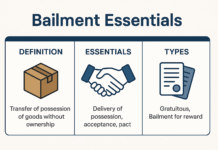Sale by Sample, Sale by Description, Auction Sale, Goods, Specific Goods, Future Goods
The Sale of Goods Act lays down the legal framework governing commercial transactions involving movable property. To navigate this framework effectively, it’s crucial to understand the precise meaning of several key terms defined within the Act. This article breaks down fourteen fundamental definitions, providing clarity and context for anyone involved in the buying and selling of goods.
1. Sale by Sample (Section 17)
A sale by sample occurs when the contract of sale explicitly or implicitly includes a term stating that the goods will correspond in quality to a sample provided to the buyer.
- Analysis: The sample serves as a visual or tangible representation of the quality and characteristics of the bulk of the goods being sold. The buyer relies on this sample to form their judgment about the overall quality of the goods they are purchasing.
- Implied Conditions (Section 17(2)): In a sale by sample, the Act implies three crucial conditions:
- Bulk corresponds with the sample: The actual goods delivered must be of the same quality as the sample.
- Reasonable opportunity for comparison: The buyer must have a fair chance to compare the bulk of the goods with the sample to ensure conformity.
- Freedom from latent defects: The goods must be free from any hidden defects that would render them unmerchantable and which would not be apparent upon a reasonable examination of the sample.
- Partial Conformity: If only a part of the delivered goods matches the sample, and the rest is inferior, the buyer has options. They can reject the entire consignment or accept the whole and claim damages for the inferior portion, unless the contract is severable (meaning the goods can be divided into independent units).
2. Sale by Description (Section 15)
A sale by description takes place when the buyer purchases goods based on a description provided by the seller. There is an implied condition that the delivered goods must correspond exactly with that description.
- Analysis: The buyer relies on the seller’s description to understand the nature, quality, and characteristics of the goods they are buying. This is common in situations where the buyer hasn’t physically inspected the goods before purchase.
- Scope of Section 15: The description must be accurate and commercially understood. Goods must not only fit the literal description but also be saleable or merchantable under that description. This extends to aspects like branding and labeling.
- Sale by Sample and Description: If a sale is by both sample and description, the bulk of the goods must conform to both the sample and the description. Mere conformity with the sample is insufficient if the goods deviate from the provided description.
3. Auction Sale (Section 64)
An auction sale is a sale conducted through competitive bidding, typically in public, where prospective buyers make increasing bids for the property, and it is usually sold to the highest bidder. Section 64 outlines specific principles governing auction sales:
- Each Lot a Separate Contract: When goods are put up for sale in lots, each lot is generally considered a separate contract of sale, unless there is evidence of a contrary intention.
- Completion of Sale: The auction sale is complete when the auctioneer announces its completion, usually by the fall of the hammer or in another customary manner. Until this announcement, any bidder can retract their bid.
- Seller’s Right to Reserve a Bid: The seller or one person on their behalf can bid at the auction if the right to do so is expressly reserved. Failure to disclose this right or employing more than one person to bid on the seller’s behalf can render the sale voidable at the buyer’s option due to fraud.
- Reserved or Upset Price: An auction sale can be subject to a reserved price (minimum price the seller will accept) or an upset price (initial minimum bid). If the highest bid is below the reserved price, the sale is not concluded.
- Pretended Bidding: If the seller uses “puffers” or pretended bids to artificially inflate the price, the sale is voidable at the buyer’s discretion.
4. “Goods” (Section 2(7))
The term “goods” under the Act encompasses every kind of movable property, excluding actionable claims (rights to sue for debt or other legal remedies) and money (the recognized currency in circulation).
- Inclusions: This broad definition includes:
- Stock and shares
- Growing crops and grass
- Things attached to or forming part of the land that are agreed to be severed before sale or under the contract of sale (e.g., standing timber to be cut down).
- Intangible assets like electrical energy, water gas, copyright, trademarks, and patents are generally considered “goods” under this definition.
- Exclusions: Actionable claims and currently circulating money are explicitly excluded. However, coins that are no longer legal tender can be bought and sold as goods (e.g., for their numismatic value).
- Partnership Interest: Notably, a partner’s interest in a partnership, being movable property and not an actionable claim, falls within the definition of “goods.”
- Wider Scope than English Law: The Indian definition of “goods” is broader than its English counterpart, specifically including stocks and shares.
5. “Specific Goods” (Section 2(14))
“Specific goods” are goods that are identified and agreed upon by both the buyer and the seller at the time the contract of sale is made.
- Analysis: The goods must be specifically pointed out and agreed upon. Mere capability of identification is not sufficient. Examples include a particular painting, a specific car with a chassis number, or a designated lot of items.
- Existence and Ascertainment: Specific goods are typically in existence and have been ascertained (identified) at the time of the contract. The seller is obligated to deliver those exact goods to fulfill the contract.
6. “Future Goods” (Section 2(6))
“Future goods” are goods that will be manufactured, produced, or acquired by the seller after the contract of sale is made.
- Analysis: These goods are not in existence at the time of the contract but are the subject of a future agreement. Examples include crops yet to be grown, goods to be manufactured according to a specific design, or goods the seller needs to purchase from a third party.
7. “Unascertained Goods”
The Act does not explicitly define “unascertained goods.” However, they are understood to be goods that are not specifically identified and agreed upon at the time the contract is made.
- Analysis: These goods are typically sold by description. The seller has the flexibility to deliver any goods that match the agreed-upon description.
- Distinction from Specific Goods: Unlike specific goods, the seller is not bound to deliver particular items but rather a quantity of goods meeting the contractual description. The goods become ascertained (and potentially specific) later, usually through appropriation to the contract (when specific goods are identified and irrevocably linked to the contract with the consent of both parties).
8. “Price” (Section 2(10))
“Price” means the money consideration for the sale of goods.
- Analysis: In a contract of sale under the Sale of Goods Act, the consideration from the buyer to the seller must be monetary. If goods are exchanged for other goods, the transaction is considered a barter or exchange and is governed by the Transfer of Property Act, not the Sale of Goods Act.
9. “Insolvent” (Section 2(8))
A person is considered “insolvent” under the Act if they have ceased to pay their debts in the ordinary course of business or cannot pay their debts as they become due, regardless of whether they have committed an act of insolvency under the relevant insolvency laws.
10. “Mercantile Agent” (Section 2(9))
A “mercantile agent” is an agent who, in the customary course of business, has the authority to:
- Sell goods.
- Consign goods for the purpose of sale.
- Buy goods.
- Raise money on the security of goods.
Examples include factors, brokers, and auctioneers acting in their professional capacity.
11. “Property” (Section 2(11))
“Property” in the context of the Act means the general property in goods, not merely a special property.
- General Property: This refers to ownership or the complete dominion over the goods.
- Special Property: This refers to a limited interest in the goods, such as that of a bailee or a pledgee. For instance, if A pledges goods to B, A retains the general property (ownership), while B has a special property (interest due to the pledge).
12. “Deliverable State” (Section 2(3))
Goods are said to be in a “deliverable state” when they are in such a condition that the buyer would, under the contract, be bound to take delivery of them. This means the goods are ready for handover according to the agreed-upon terms.
13. “Document of Title to Goods” (Section 2(4))
A “document of title to goods” includes various documents used in the ordinary course of business as proof of possession or control of goods, or authorizing the possessor to transfer or receive the goods represented by the document. Examples include:
- Bill of lading
- Dock warrant
- Warehouse-keeper’s certificate
- Wharfinger’s certificate
- Railway receipt
- Warrant or order for the delivery of goods
- Any other similar document recognized in commercial practice.
14. “Delivery” (Section 2(2))
“Delivery” means the voluntary transfer of possession of goods from one person (the seller or their agent) to another (the buyer or their agent). It signifies the physical handover or the transfer of control over the goods with the intention of transferring possession.
Understanding these fundamental definitions is crucial for interpreting and applying the provisions of the Sale of Goods Act. They provide the necessary clarity and precision for navigating the legal complexities of buying and selling movable property in India.
















